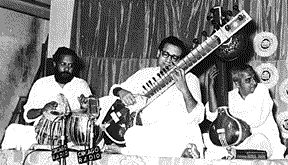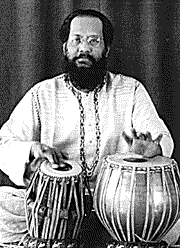
Photo: R.M. Kumtakar courtesy Sangit Mahabharati

Photo: R.M. Kumtakar courtesy Sangit Mahabharati
By Nikhil Ghosh
He was one of the finest sitarists of our times, who remained a student at heart in spite of overwhelming success and adulation. He has left his mark on the sands of time. We were very close to each other since I first met him in 1949, when I was accompanying Ustad Allauddin Khan at a concert in Delhi, and Nikhil was at the tamboura. In later years he was also associated with Sangit Mahabharati since its inception in 1956. He gave several performances in aid of Sangit Mahabharati in its early years and finally a recital in 1983, which, by popular recollection, was one of his most moving recitals. I was on the tabla. Decades of memorable performances together came to my mind in a flash, when he asked me for my Ijazat (permission) saying, "Nikhilda, shall I start?"
Ever since I knew him, his enquiring mind always prompted him to ask me about so many technicalities, handling talas like Dhamar, Pancham Sawari, Nasruk and more significantly, about musical concepts and attitudes, during those long train journeys for our numerous concert tours all over India. He was one of those few sitarists who performed in unusual talas with an enviable elegance.
What was most noteworthy about him was that he spent hours in contemplation. He knew well that he would derive his strength from this. That was how his musical energy on stage never showed any signs of flagging in an entire recital.
The younger generation of today's musicians will be missing an example of true musicianship.
By Mohan Nadkarni
Bombay, March 3rd, 1995: One of the most dynamic personalities in the world of traditional music passed into oblivion with the death of Pandit Nikhil Ghosh in the early hours of today. He was 76 and in indifferent health for some time.
He leaves behind his wife Usha, sons Nayan and Dhruba, and daughter, Tulika, on whose shoulders fall the onerous responsibilities of carrying forward his Sangit Mahabharati's affairs has now fallen.
Nikhilbabu and Sangit Mahabharati had become synonymous to all those who knew about the immense and seemingly insuperable task that Panditji had undertaken and pledged to make a reality. Initially, it was a modest school, where Nikhilbabu, as its principal, imparted musical education to aspiring youngsters way back in 1956.
 Photo: Nayan Ghosh courtesy
Sangit Mahabharati
Photo: Nayan Ghosh courtesy
Sangit Mahabharati
Side by side, he toyed with the idea of giving shape to his own idea of the field, and set about the task of its propagation in several ways. That is how the original Arun Sangeetalaya began to undergo a transformation to emerge as Sangit Mahabharati today.
The institution now has a building of its own in the Juhu-Vile Parle belt in the northern suburbs of Bombay. Even a casual visit to the institution anytime during its work hours is enough to convince one of the kind of work in progress there - teaching, research and documentation, in addition to providing for courses leading up to diploma and post-graduate levels on the basis of a competitive curriculum formulated by Panditji himself.
To facilitate his own method of teaching, Nikhilbabu wrote a definitive book, Fundamentals of Raga and Tala with a New System of Notation, for use in his institution. The idea was to prepare the ground for future performers, who would emerge from scholastic education courses into worthy propagators of guru-shishya parampara.
Looking back, one would be inclined to say that Pandit Ghosh was one stalwart who strove to realize, singly, the combined ambitions of many of his confreres in the field - as a vocalist, instrumentalist, percussionist, musicologist and educator.
He was the younger brother of the late flute maestro Pannalal Ghosh. Born in Barisal, now in Bangladesh, in 1919, Nikhilbabu derived his inspiration from his sitarist father Akshyakumar Ghosh, and achieved quite a command over the sitar. Later, at the instance of Pannababu, he secured tutelage with octogenarian singer, harmonium player and percussionist Pandit Gyan Prakash Ghosh.
Although, under his mentor's guidance he learned singing and tabla playing, the disciple was deeply involved in the latter and soon earned name and fame as a master percussionist. He became a favorite accompanist of many all-time greats like Omkarnath Thakur, Ravi Shankar, Ali Akbar Khan, and last but not least, his brother Pannalal Ghosh.
On coming to Bombay in the 1940s, he benefited from guidance in percussion music from maestros of the eminence of Amir Hussain Khan and his elder gurubai, Ahmadjan Thirakwa. After the untimely death of Pannababu in 1960, Nikhilbabu it would seem, chose to gradually withdraw from the concert circuit to devote himself completely to teaching and propagating Hindustani music through his institution.
Honors and accolades came his way in the form of the Padma Bhushan and the Hafiz Ali Khan Smriti Samman, besides several others. His children have already made their mark at national and international levels in their own way - Nayan as a percussionist and sitarist, Dhruba as a sarangi player, and Tulika as a vocalist. - © 1995 Times of India
Apart from his beautiful music, the main thing I remember strongly about Nikhil Banerjee is his soft manner and extreme modesty. In fact, when I asked him for permission to record the concert, he said: "Why? I am not good enough yet. Better record me another time, later!" Of course, what was very special in this concert and for me the first time I heard it: the tarparan, the tabla joining in the jor section of the Bilaskhani Todi alap. Nikhil Banerjee explained to me that tarparan was a technique borrowed from the way rudra vina and pakhavaj play together in the dhrupad style.---From a letter by Felix van Lamsweerde
Released by arrangement with Mrs. Roma Banerjee. Research Consultant: Ira Landgarten. Morning concert arranged by Alankar Music Circle. Recorded at Indian Merchants Chamber Hall, Churchgate, Bombay by Felix van Lamsweerde on 14 March 1965. Nagra III full track mono recorder. Nagra BM mixer. Microphones: AKG dynamic plus Sennheiser MKH 104 condenser (sitar); MD 211 dynamic (tabla). Full track mono Nagra playback. Cover photo by Bhaidu Sanyal courtesy John Campana. Booklet photo on page 3 of Nikhil Banerjee by Ira Landgarten; photo on page 5 of Nikhil Ghosh courtesy Peter Guinan. Traycard photos by R.M. Kumtakar courtesy Sangit Mahabharati. Special thanks to Dhruba Ghosh, Kevin Rafferty, Peter Guinan, Subrata Chowdhury, Maitreya Padukone. Produced by John Wilton.
Back to Raga-216